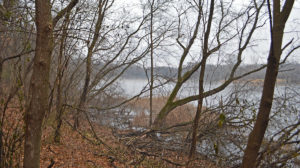
District proceeds with plans to optimize drainage near Grass Lake and Snail Lake
Winter weather means construction season in the watershed world, and we are moving forward with plans to optimize drainage and restore natural habitat in the Grass Lake and Snail Lake area. This work is part of an ongoing study commissioned by the District in response to persistent high water conditions and concerns among local residents.

Projects underway
- Natural habitat restoration
In partnership with Ramsey County, we were recently awarded a Conservation Partners Legacy Grant of $252,000 from the Minnesota DNR to restore 60 acres of degraded forest and about four acres of wetland habitat. This 4-year project will begin this year as we remove invasive vegetation like buckthorn and prepare the site for native planting. - Grass Lake berm
Plans are underway to construct a permanent berm along the north side of Grass Lake to replace two sections of temporary sandbags. The berm will help contain high waters on the lake’s northern shoreline. - Twin culverts under Ramsey County trail
East of the berm, we plan to add two 44-inch by 26-inch culverts to carry water from Grass Lake underneath the Ramsey County walking trail to an adjacent marsh. This will improve drainage beyond the smaller 18-inch culvert currently running underneath the trail. - Dredge Grass Lake east shoreline
We will remove about 775 cubic yards of sediment along east shoreline of Grass Lake and dig out a 360-foot-long channel 2 feet below the lake bottom to allow better drainage to the new culverts being installed. - Improve channel between Grass Lake and railroad tracks
To improve flow between Grass Lake and a wetland area near the railroad tracks to the east, we will remove about 1,825 cubic yards of sediment and dig out a 560-foot-long channel. - Improve channel into West Vadnais Lake
To improve flow from Grass Lake into West Vadnais Lake, we will remove about 160 cubic yards of sediment from the downstream end of two Rice Street culverts. Riprap will be placed at the end of the culverts to keep sediment from building up in the future. - Replace West Vadnais Blvd. culvert
To keep water flowing south under West Vadnais Boulevard, we will replace the current 12-inch culvert with a larger and slightly lower 44-inch by 26-inch culvert. - Improve West Vadnais Lake outlet
We are pursuing permits to improve the West Vadnais Lake outlet, which flows south under I-694, by replacing a section of the current 15-inch pipe with a larger 24-inch pipe. In addition, a new trash guard and riprap will help keep debris from blocking the outlet.
Potential projects
We are studying the feasibility of several potential projects to create additional water storage within the Grass/Snail Lake system or move water out of the system. These options are outlined in a recent Barr Engineering study and include:
- Installing an outlet pipe from Snail Lake, which is currently landlocked, to Grass Lake. The pipe would be equipped with a manual gate to prevent backflow into Snail Lake, and only opened when Grass Lake water levels are low enough to accept flows from Snail.
- Pumping water from Snail Lake to Sucker Lake in order to lower water levels in Snail Lake. An augmentation pipe is currently in place to carry water from Sucker to Snail (when Snail Lake levels are low), but it was not designed to work in reverse.
- Study the connection between Snail Lake and the marsh bordering it to the northwest to confirm its connection to Snail Lake and its availability to store Snail Lake flood waters.
- Managing water levels in ponds around Gramsie Road.
- Constructing an emergency overflow on Grass Lake that would carry water north in very large storm events, reducing the risk of Rice Street flooding.
- Lowering the outlet for West Vadnais Lake to create additional water storage in both West Vadnais and Grass lakes.
- Installing a system to pump and treat water from West Vadnais into East Vadnais Lake in order to promote drainage of the entire Grass/Snail lake system. Since St. Paul draws its drinking water from East Vadnais Lake, any water pumped there would need to meet strict quality standards according to St. Paul Regional Water Services and other regulators.
Questions or comments? Join the conversation on our Facebook page, or drop us an email.